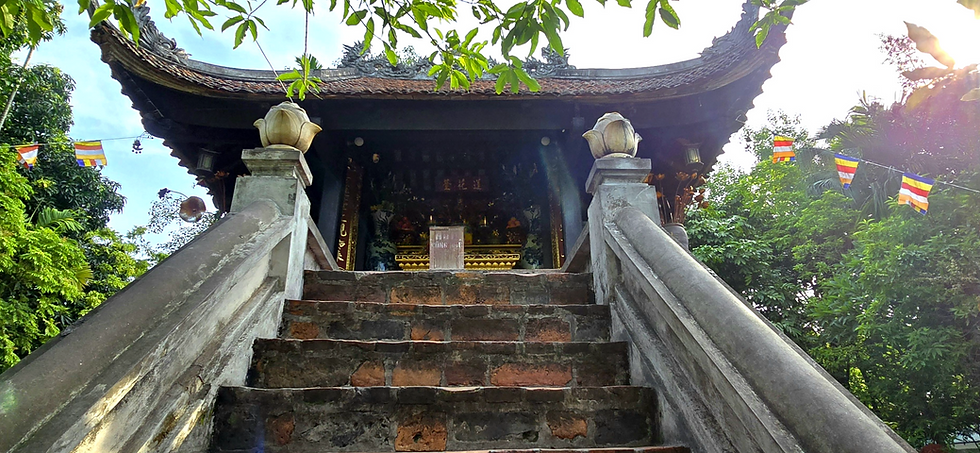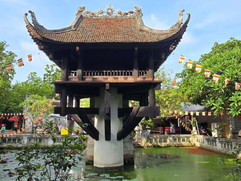One Pillar Lotus Pagoda
- shan157
- Jun 23
- 4 min read
Updated: Jun 26
Regarded as one of Vietnam's most iconic architectural treasures, the original One Pillar Pagoda was constructed in 1049AD by Emperor Lý Thái Tông. Officially named Diên Hựu Tự, which translates to the “Temple of Long-Lasting Blessings,” this historic Buddhist shrine is dedicated to Quan Âm, the Bodhisattva of Compassion and has long been a site of worship, particularly for those seeking blessings for fertility and health.

According to historical records, the Emperor, who was heirless and deeply troubled by the lack of a successor, had a vivid dream in which the Goddess of Mercy appeared before him. In the vision, she presented him with a precious baby boy, cradled gently on a blooming lotus flower, a powerful symbol of purity and divine favour in Buddhism. Not long after this sacred encounter, his consort miraculously gave birth to a son. Interpreting the dream as a heavenly blessing and a sign of spiritual intervention, the Emperor was overwhelmed with gratitude. In devotion to Quan Âm and as a gesture of thanks, he commissioned the construction of the pagoda, deliberately designing it to resemble a lotus rising from the water, echoing the very image from his vision.

The pagoda emerges from the centre of a square lotus pond known as Liên Hoa Đài (the Lotus Platform), supported by a single monolithic stone pillar that evokes the Buddhist journey, rising pure and unstained from a sea of sorrow. Atop the pillar sits a small, square wooden structure crowned with a curved tiled roof, a classic feature of Vietnamese architecture. The lotus flower, central to the design, symbolises spiritual awakening as it blooms above murky waters. The surrounding complex includes smaller shrines and temples dedicated to Buddhist deities, while the stillness of the pond below mirrors the pagoda, deepening the space’s quiet, meditative aura.
Beneath its peaceful appearance, the One Pillar Pagoda carries a weight of darker folklore often left out of official narratives. One enduring tale speaks of a lingering curse tied to its destruction during the French colonial period. Locals claim that the demolition of the original structure in 1954, seen by many as an act of spiritual desecration, provoked the wrath of guardian spirits tied to the land. Not long after, reports surfaced of misfortunes befalling the French troops involved, including a string of mysterious illnesses and unexplained deaths. For some, these events were more than coincidence, they were seen as evidence of supernatural retribution for disturbing a sacred place.

Another, more obscure legend speaks to the moral weight carried by the temple itself. It tells of a monk who, having broken his vows within the temple grounds, was cursed for his betrayal of the Dharma. According to the story, he was transformed into a fish and condemned to swim endlessly beneath the surface of the lotus pond, visible only on nights when the moon is full and the water perfectly still. This tale serves as both a cautionary reminder of karma and a warning about the consequences of spiritual transgression in a place as revered as the One Pillar Pagoda.

In 1962, the One Pillar Pagoda was officially recognised by the Vietnamese government as a historical and cultural relic, a designation that affirmed its significance not just as a religious site but as a treasured part of the nation's identity. This recognition came during a time of rebuilding and reflection, further anchoring the pagoda’s role in Vietnam’s cultural memory. Over the decades, it has been carefully restored and maintained, surviving war, political change and urban development while continuing to draw pilgrims, tourists and scholars alike.
In 2006, the pagoda was awarded a place in the Vietnamese Guinness Book of Records as the temple with the most unique architecture in the country, a nod to its striking design. This architectural rarity, deeply symbolic and aesthetically distinctive, has helped solidify its reputation not just in Vietnam but around the globe. Today, the One Pillar Pagoda stands as more than just a place of worship, it is a living symbol of national resilience, spiritual continuity and the enduring legacy of Vietnamese ingenuity and faith.
Location : Ong Ich Khiem Street, Ngoc Ha, Doi Can Ward, Ba Dinh District, Hà Nội
How to get there : The One Pillar Pagoda is situated in Hanoi's Ba Dinh District, approximately 3-4km's southwest of the Old Quarter, close to the Ho Chi Minh Mausoleum. Walking from the Old Quarter will take about half an hour and offers an opportunity to explore the city en route. Alternatively, visitors can reach the pagoda within 15 minutes with a Grab taxi for only a few dollars.
Attraction Info : The pagoda is open from 7am to 6am everyday of the year. Admission is a nominal fee of 25000 VND. As the site holds religious significance, visitors are expected to dress modestly, covering shoulders and knees, to show respect for local customs.

Thanks for reading about the One Pillar Lotus Pagoda. Check out more destinations here!










































